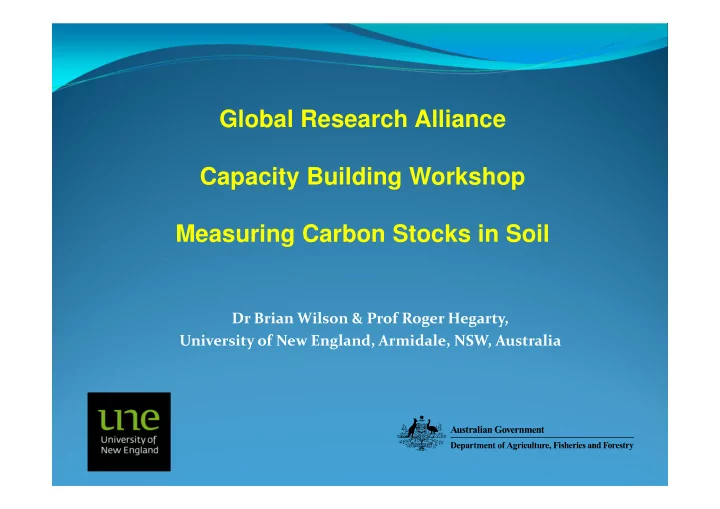

Global Research Alliance Capacity Building Workshop Measuring Carbon Stocks in Soil Dr Brian Wilson & Prof Roger Hegarty, University of New England, Armidale, NSW, Australia
Outline • Background • Methodologies – protocols and technical considerations • Sources of Variation/uncertainty • Sampling • Spatial • Temporal
Background GHG Emissions Projections • Australia - average 582 Mt CO 2 -e per year Kyoto period (2008–12) • Projected to be +24% by 2020 (without mitigation) • Require abatement of between 160 Mt CO 2 -e and 272 Mt CO 2 -e in 2020 • Soil is the largest terrestrial C store • SOC key component of abatement • Carbon Farming Initiative (CFI) 3
National change in soil C in cropped soils 2010 Australian National Inventory Require measured data to estimate, predict and model these changes
Measurement Methodology: Protocols and Technical Considerations
Methodology How do we measure soil C ? Require reliable, robust, consistent measures of soil carbon to identify auditable change over time. Factors that need consideration : � Sampling protocol � Spatial variability � Temporal variability � Laboratory/measurement error 6
Sampling Protocols (measured data) SOC tC ha -1 = SOC% x Soil Depth x Bulk Density x Area Sample depths • 0-5cm/0-10cm ? • 10-20cm • 20-30cm Sample preparation • Generally sieved to <2mm • Gravel Content Correction Inclusion of plant matter will • Bulk Density Calculation alter result by factor of 2
Calculating Soil Carbon (tC ha -1 ) Equivalent Mass Equivalent Mass BD 1.2 t/m 3 BD 1.0 t/m 3 30cm 36cm Mass of soil to 30cm @ BD 1.2 t/m 3 0.3 x 10,000 x 1.2 = 3,600 tonnes
Sources of Variability/Uncertainty in soil carbon estimation • Spatial • Temporal • Laboratory
Spatial Variability: sampling design Australian Sampling Transect sampling strategy 10 DPI Victoria
Spatial Variability: sample numbers How many samples are required ? Is our sample representative of the site / landscape ? Minimum detectable difference between samplings Don et al. (2007) 100 samples .............>0.4 tC/ha (Arenosol) OR > 0.8tC/ha (Vertisol) 20 samples .............>1.2 > 2.8 As sample number increases so does precision and confidence – inherent variability = diminishing returns Sampling strategies designed around cost and practicality ! Standard number – defined precision/confidence ?
Temporal Variability 40% variation between winter and spring (Kikuyu grass - Skjemstad unpublished) 5 4 C Sequestration 3 tC/ha/yr 2 1 0 May July Sept Dec Mar
Temporal Variability: repeat sampling Temporal Variability in SOC 2008-2011 140 120 100 Soil Carbon (tC/ha) 80 Series1 Series2 60 40 20 0 Cropping Improved Pasture Native Pasture Woodland Wilson et al. Unpublished Data 13
Laboratory measurements What laboratory test is used to analyse for soil carbon ? Methods of analysis • Walkley and Black • Heanes wet oxidation • Leco furnace • NIR & MIR 14
Other Considerations � Should we measure at all ?? (requirements for C trading) 15
Over what time frame should we monitor for soil carbon ? Example: NSW pastures (TOC) 44 4 – 5 yrs 42 40 1 tC/ha/yr emission 38 36 - Simulated 34 Observed 32 Yin Chan – NSW Climate Change Action Program 30 28 1990 1992 1994 1996 1998 2000 2002 2004 2006 2008 16 Simulations based on FullCam (incorporating RothC)
Example: NSW pastures (TOC) 44 42 40 } 0.1 tC/ha/yr sink 38 tC/ha 7 yrs 36 34 - Simulated 32 Observed 30 28 1990 1992 1994 1996 1998 2000 2002 2004 2006 2008 17
Example: NSW pastures (TOC) 44 42 40 2.3 38 tC/ha/yr sink tC/ha 36 34 - Simulated 32 Observed 30 28 1990 1992 1994 1996 1998 2000 2002 2004 2006 2008 18
Soil Carbon in GHG Accounts
Measurement programs Combined sources of variability: Field sampling ( 15 - 40%CV ) 7.5 – 20 tC/ha [ includes spatial & analytical ] (McKenzie et al. 2002, Brown 1999, Janik et al. 2002) Bulk density (Timm et al. 2004, Sanderman et al. In press) 5 - 10 tC/ha (10-20% CV) Combined variability = � 7.5 2 +5 2 = 9 - 22 tC/ha
Comparison between FullCAM and measured soil data • Roth C • DNDC • DayCent/Century Similar results 120 110 100 ± 10 tC/ha y = 0.9572x + 1.144 Modelled Soil Carbon (t/ha) 90 R² = 0.8805 80 70 60 50 40 30 20 10 0 0 10 20 30 40 50 60 70 80 90 100 110 -10 Measured Soil Carbon (t/ha) 21
Conclusions • All countries need to report on GHG emissions • Soil Carbon a potentially significant store • Require reliable, robust and repeatable measures of soil carbon • Measurement associated with a range of sources of variability • Spatial • Temporal • Laboratory • Measurement programs need to account for this variability • Modeling has promise for SOC estimation with defined confidence • BUT Data hungry, propagation of errors ? • Need to define precision and confidence. 22
Thank You Questions ?
Recommend
More recommend